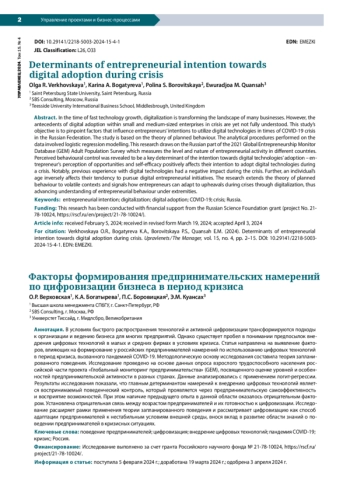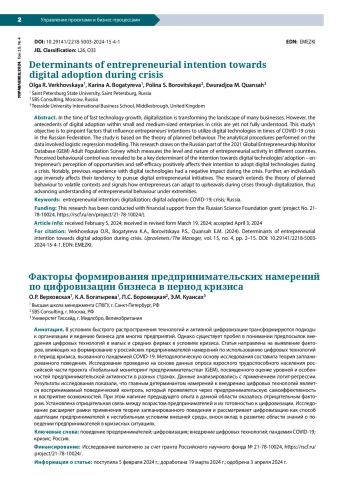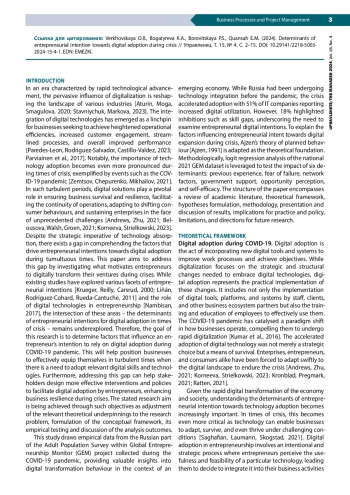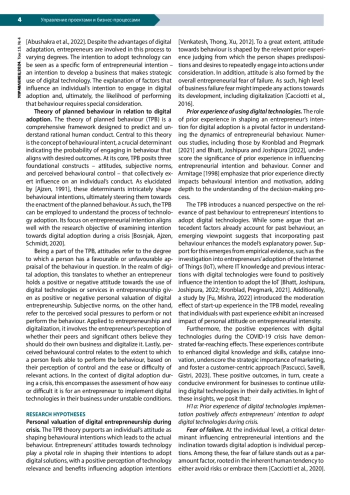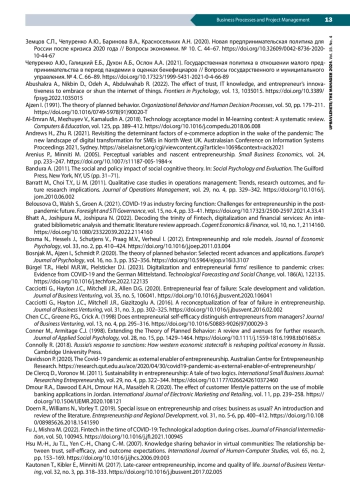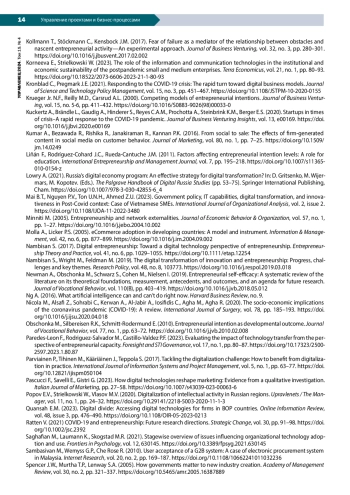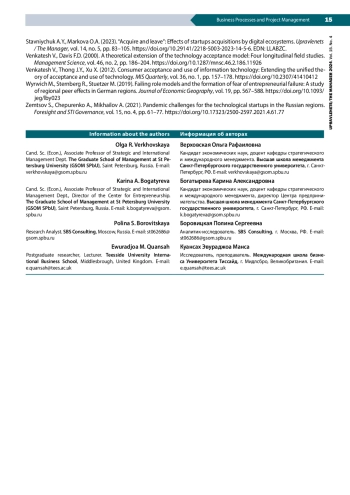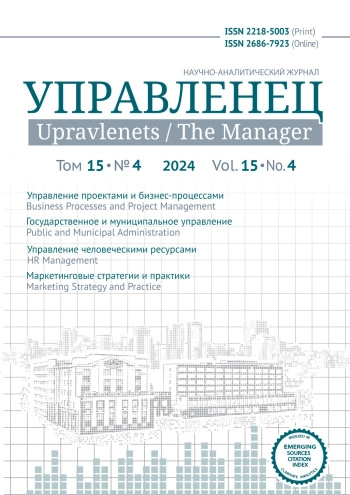In the time of fast technology growth, digitalization is transforming the landscape of many businesses. However, the antecedents of digital adoption within small and medium-sized enterprises in crisis are yet not fully understood. This study’s objective is to pinpoint factors that influence entrepreneurs’ intentions to utilize digital technologies in times of COVID-19 crisis in the Russian Federation. The study is based on the theory of planned behaviour. The analytical procedures performed on the data involved logistic regression modelling. This research draws on the Russian part of the 2021 Global Entrepreneurship Monitor Database (GEM) Adult Population Survey which measures the level and nature of entrepreneurial activity in different countries. Perceived behavioural control was revealed to be a key determinant of the intention towards digital technologies’ adoption – entrepreneur’s perception of opportunities and self-efficacy positively affects their intention to adopt digital technologies during a crisis. Notably, previous experience with digital technologies had a negative impact during the crisis. Further, an individual’s age inversely affects their tendency to pursue digital entrepreneurial initiatives. The research extends the theory of planned behaviour to volatile contexts and signals how entrepreneurs can adapt to upheavals during crises through digitalization, thus advancing understanding of entrepreneurial behaviour under extremities
Идентификаторы и классификаторы
- SCI
- Социология
- УДК
- 316. Социология
In an era characterized by rapid technological advancement, the pervasive influence of digitalization is reshaping the landscape of various industries [Aturin, Moga, Smagulova, 2020; Stavniychuk, Markova, 2023]. The integration of digital technologies has emerged as a linchpin for businesses seeking to achieve heightened operational efficiencies, increased customer engagement, streamlined processes, and overall improved performance [Paredes-Leon, Rodriguez-Salvador, Castillo-Valdez, 2023; Parviainen et al., 2017].
Список литературы
1. Aturin V.V., Moga I.S., Smagulova S.M. (2020). Digital transformation management: Scientific approaches and economic policy. Upravlenets / The Manager, vol. 11, no. 2, pp. 67-76. 10.29141/2218-5003-2020-11-2-6. (in Russ.). DOI: 10.29141/2218-5003-2020-11-2-6.(inRuss.) EDN: HVUVWR
2. Zemtsov S.P., Chepurenko A.Y., Barinova V.A., Krasnoselskih A.N. (2020). New entrepreneurship policy in Russia after the 2020 crisis. Voprosy Ekonomiki, no. 10, pp. 44-67. (in Russ.). DOI: 10.32609/0042-8736-2020-10-44-67 EDN: EBTJFG
3. Chepurenko A.Yu., Galitsky E.B., Dukhon A.B., Oslon A.A. (2021). State policy towards small businesses during the pandemic in the estimates of potential beneficiaries. Voprosy gosudarstvennogo i munitsipalnogo upravleniya / Public Administration Issues, no. 4, pp. 66-89. 10.17323/1999-5431-2021-0-4-66-89. (in Russ.). DOI: 10.17323/1999-5431-2021-0-4-66-89.(inRuss.) EDN: HPZYXQ
4. Abushakra A., Nikbin D., Odeh A., Abdulwahab R. (2022). The effect of trust, IT knowledge, and entrepreneur’s innovativeness to embrace or shun the internet of things. Frontiers in Psychology, vol. 13, 1035015. DOI: 10.3389/fpsyg.2022.1035015
5. Ajzen I. (1991). The theory of planned behavior. Organizational Behavior and Human Decision Processes, vol. 50, pp. 179-211. DOI: 10.1016/0749-5978(91)90020-T
6. Al-Emran M., Mezhuyev V., Kamaludin A. (2018). Technology acceptance model in M-learning context: A systematic review. Computers & Education, vol. 125, pp. 389-412. DOI: 10.1016/j.compedu.2018.06.008
7. Andrews H., Zhu R. (2021). Revisiting the determinant factors of e-commerce adoption in the wake of the pandemic: The new landscape of digital transformation for SMEs in North West UK. Australasian Conference on Information Systems Proceedings 2021, Sydney. https://aisel.aisnet.org/cgi/viewcontent.cgi?article=1069&context=acis2021.
8. Arenius P., Minniti M. (2005). Perceptual variables and nascent entrepreneurship. Small Business Economics, vol. 24, pp. 233-247. DOI: 10.1007/s11187-005-1984-x EDN: FSITHP
9. Bandura A. (2011). The social and policy impact of social cognitive theory. In: Social Psychology and Evaluation. The Guilford Press, New York, NY, US (pp. 31-71).
10. Barratt M., Choi T.Y., Li M. (2011). Qualitative case studies in operations management: Trends, research outcomes, and future research implications. Journal of Operations Management, vol. 29, no. 4, pp. 329-342. DOI: 10.1016/j.jom.2010.06.002 EDN: OEQSKR
11. Belousova O., Walsh S., Groen A. (2021). COVID-19 as industry forcing function: Challenges for entrepreneurship in the post-pandemic future. Foresight and STI Governance, vol. 15, no. 4, pp. 33-41. DOI: 10.17323/2500-2597.2021.4.33.41 EDN: OHPFTH
12. Bhatt A., Joshipura M., Joshipura N. (2022). Decoding the trinity of Fintech, digitalization and financial services: An integrated bibliometric analysis and thematic literature review approach. Cogent Economics & Finance, vol. 10, no. 1, 2114160. DOI: 10.1080/23322039.2022.2114160 EDN: LAGGZE
13. Bosma N., Hessels J., Schutjens V., Praag M.V., Verheul I. (2012). Entrepreneurship and role models. Journal of Economic Psychology, vol. 33, no. 2, pp. 410-424. DOI: 10.1016/j.joep.2011.03.004
14. Bosnjak M., Ajzen I., Schmidt P. (2020). The theory of planned behavior: Selected recent advances and applications. Europe’s Journal of Psychology, vol. 16, no. 3, pp. 352-356. DOI: 10.5964/ejop.v16i3.3107 EDN: JMSMDB
15. Bürgel T.R., Hiebl M.R.W., Pielsticker D.I. (2023). Digitalization and entrepreneurial firms’ resilience to pandemic crises: Evidence from COVID-19 and the German Mittelstand. Technological Forecasting and Social Change, vol. 186(A), 122135. DOI: 10.1016/j.techfore.2022.122135
16. Cacciotti G., Hayton J.C., Mitchell J.R., Allen D.G. (2020). Entrepreneurial fear of failure: Scale development and validation. Journal of Business Venturing, vol. 35, no. 5, 106041. DOI: 10.1016/j.jbusvent.2020.106041 EDN: OCDMQA
17. Cacciotti G., Hayton J.C., Mitchell J.R., Giazitzoglu A. (2016). A reconceptualization of fear of failure in entrepreneurship. Journal of Business Venturing, vol. 31, no. 3, pp. 302-325. DOI: 10.1016/j.jbusvent.2016.02.002
18. Chen C.C., Greene P.G., Crick A. (1998) Does entrepreneurial self-efficacy distinguish entrepreneurs from managers? Journal of Business Venturing, vol. 13, no. 4, pp. 295-316. DOI: 10.1016/S0883-9026(97)00029-3 EDN: AAVJZT
19. Conner M., Armitage C.J. (1998). Extending the Theory of Planned Behavior: A review and avenues for further research. Journal of Applied Social Psychology, vol. 28, no. 15, pp. 1429-1464. DOI: 10.1111/j.1559-1816.1998.tb01685.x EDN: GWWFMR
20. Connolly R. (2018). Russia’s response to sanctions: How western economic statecraft is reshaping political economy in Russia. Cambridge University Press.
21. Davidsson P. (2020). The Covid-19 pandemic as external enabler of entrepreneurship. Australian Centre for Entrepreneurship Research. https://research.qut.edu.au/ace/2020/04/30/covid19-pandemic-as-external-enabler-of-entrepreneurship.
22. De Clercq D., Voronov M. (2011). Sustainability in entrepreneurship: A tale of two logics. International Small Business Journal: Researching Entrepreneurship, vol. 29, no. 4, pp. 322-344. DOI: 10.1177/0266242610372460
23. Dmour R.A., Dawood E.A.H., Dmour H.A., Masa’deh R. (2020). The effect of customer lifestyle patterns on the use of mobile banking applications in Jordan. International Journal of Electronic Marketing and Retailing, vol. 11, pp. 239-258. DOI: 10.1504/IJEMR.2020.108121 EDN: OXZEPE
24. Doern R., Williams N., Vorley T. (2019). Special issue on entrepreneurship and crises: business as usual? An introduction and review of the literature. Entrepreneurship and Regional Development, vol. 31, no. 5-6, pp. 400-412. DOI: 10.1080/08985626.2018.1541590
25. Fu J., Mishra M. (2022). Fintech in the time of COVID-19: Technological adoption during crises. Journal of Financial Intermediation, vol. 50, 100945. DOI: 10.1016/j.jfi.2021.100945
26. Hsu M.-H., Ju T.L., Yen C.-H., Chang C.-M. (2007). Knowledge sharing behavior in virtual communities: The relationship between trust, self-efficacy, and outcome expectations. International Journal of Human-Computer Studies, vol. 65, no. 2, pp. 153-169. DOI: 10.1016/j.ijhcs.2006.09.003 EDN: XUKLEO
27. Kautonen T., Kibler E., Minniti M. (2017). Late-career entrepreneurship, income and quality of life. Journal of Business Venturing, vol. 32, no. 3, pp. 318-333. DOI: 10.1016/j.jbusvent.2017.02.005
28. Kollmann T., Stöckmann C., Kensbock J.M. (2017). Fear of failure as a mediator of the relationship between obstacles and nascent entrepreneurial activity-An experimental approach. Journal of Business Venturing, vol. 32, no. 3, pp. 280-301. DOI: 10.1016/j.jbusvent.2017.02.002
29. Korneeva E., Strielkowski W. (2023). The role of the information and communication technologies in the institutional and economic sustainability of the postpandemic small and medium enterprises. Terra Economicus, vol. 21, no. 1, pp. 80-93. DOI: 10.18522/2073-6606-2023-21-1-80-93 EDN: UBUSAR
30. Kronblad C., Pregmark J.E. (2021). Responding to the COVID-19 crisis: The rapid turn toward digital business models. Journal of Science and Technology Policy Management, vol. 15, no. 3, pp. 451-467. DOI: 10.1108/JSTPM-10-2020-0155 EDN: QFZIPQ
31. Krueger Jr. N.F., Reilly M.D., Carsrud A.L. (2000). Competing models of entrepreneurial intentions. Journal of Business Venturing, vol. 15, no. 5-6, pp. 411-432. DOI: 10.1016/S0883-9026(98)00033-0 EDN: AIAXZN
32. Kuckertz A., Brändle L., Gaudig A., Hinderer S., Reyes C.A.M., Prochotta A., Steinbrink K.M., Berger E.S. (2020). Startups in times of crisis-A rapid response to the COVID-19 pandemic. Journal of Business Venturing Insights, vol. 13, e00169. DOI: 10.1016/j.jbvi.2020.e00169 EDN: TUHFMZ
33. Kumar A., Bezawada R., Rishika R., Janakiraman R., Kannan P.K. (2016). From social to sale: The effects of firm-generated content in social media on customer behavior. Journal of Marketing, vol. 80, no. 1, pp. 7-25. DOI: 10.1509/jm.14.0249
34. Liñán F., Rodríguez-Cohard J.C., Rueda-Cantuche J.M. (2011). Factors affecting entrepreneurial intention levels: A role for education. International Entrepreneurship and Management Journal, vol. 7, pp. 195-218. DOI: 10.1007/s11365-010-0154-z
35. Lowry A. (2021). Russia’s digital economy program: An effective strategy for digital transformation? In: D. Gritsenko, M. Wijermars, M. Kopotev. (Eds.). The Palgrave Handbook of Digital Russia Studies (pp. 53-75). Springer International Publishing, Cham. DOI: 10.1007/978-3-030-42855-6_4
36. Mai B.T., Nguyen P.V., Ton U.N.H., Ahmed Z.U. (2023). Government policy, IT capabilities, digital transformation, and innovativeness in Post-Covid context: Case of Vietnamese SMEs. International Journal of Organizational Analysis, vol. 2, issue 2. DOI: 10.1108/IJOA-11-2022-3480
37. Minniti M. (2005). Entrepreneurship and network externalities. Journal of Economic Behavior & Organization, vol. 57, no. 1, pp. 1-27. DOI: 10.1016/j.jebo.2004.10.002 EDN: XROYDQ
38. Molla A., Licker P.S. (2005). eCommerce adoption in developing countries: A model and instrument. Information & Management, vol. 42, no. 6, pp. 877-899. DOI: 10.1016/j.im.2004.09.002
39. Nambisan S. (2017). Digital entrepreneurship: Toward a digital technology perspective of entrepreneurship. Entrepreneurship Theory and Practice, vol. 41, no. 6, pp. 1029-1055. DOI: 10.1111/etap.12254
40. Nambisan S., Wright M., Feldman M. (2019). The digital transformation of innovation and entrepreneurship: Progress, challenges and key themes. Research Policy, vol. 48, no. 8, 103773. DOI: 10.1016/j.respol.2019.03.018
41. Newman A., Obschonka M., Schwarz S., Cohen M., Nielsen I. (2019). Entrepreneurial self-efficacy: A systematic review of the literature on its theoretical foundations, measurement, antecedents, and outcomes, and an agenda for future research. Journal of Vocational Behavior, vol. 110(B), pp. 403-419. DOI: 10.1016/j.jvb.2018.05.012
42. Ng A. (2016). What artificial intelligence can and can’t do right now. Harvard Business Review, no. 9.
43. Nicola M., Alsafi Z., Sohrabi C., Kerwan A., Al-Jabir A., Iosifidis C., Agha M., Agha R. (2020). The socio-economic implications of the coronavirus pandemic (COVID-19): A review. International Journal of Surgery, vol. 78, pp. 185-193. DOI: 10.1016/j.ijsu.2020.04.018 EDN: YUTKZP
44. Obschonka M., Silbereisen R.K., Schmitt-Rodermund E. (2010). Entrepreneurial intention as developmental outcome. Journal of Vocational Behavior, vol. 77, no. 1, pp. 63-72. DOI: 10.1016/j.jvb.2010.02.008
45. Paredes-Leon F., Rodriguez-Salvador M., Castillo-Valdez P.F. (2023). Evaluating the impact of technology transfer from the perspective of entrepreneurial capacity. Foresight and STI Governance, vol. 17, no. 1, pp. 80-87. DOI: 10.17323/2500-2597.2023.1.80.87 EDN: OCWPYS
46. Parviainen P., Tihinen M., Kääriäinen J., Teppola S. (2017). Tackling the digitalization challenge: How to benefit from digitalization in practice. International Journal of Information Systems and Project Management, vol. 5, no. 1, pp. 63-77. DOI: 10.12821/ijispm050104 EDN: QTKIFX
47. Pascucci F., Savelli E., Gistri G. (2023). How digital technologies reshape marketing: Evidence from a qualitative investigation. Italian Journal of Marketing, pp. 27-58. DOI: 10.1007/s43039-023-00063-6
48. Popov E.V., Strielkowski W., Vlasov M.V. (2020). Digitalization of intellectual activity in Russian regions. Upravlenets / The Manager, vol. 11, no. 1, pp. 24-32. DOI: 10.29141/2218-5003-2020-11-1-3 EDN: DOYYNO
49. Quansah E.M. (2023). Digital divide: Accessing digital technologies for firms in BOP countries. Online Information Review, vol. 48, issue 3, pp. 476-490. DOI: 10.1108/OIR-05-2023-0213 EDN: BLLKYZ
50. Ratten V. (2021) COVID-19 and entrepreneurship: Future research directions. Strategic Change, vol. 30, pp. 91-98. DOI: 10.1002/jsc.2392 EDN: RGATTH
51. Saghafian M., Laumann K., Skogstad M.R. (2021). Stagewise overview of issues influencing organizational technology adoption and use. Frontiers in Psychology, vol. 12, 630145. DOI: 10.3389/fpsyg.2021.630145 EDN: UYOUYK
52. Sambasivan M., Wemyss G.P., Che Rose R. (2010). User acceptance of a G2B system: A case of electronic procurement system in Malaysia. Internet Research, vol. 20, no. 2, pp. 169-187. DOI: 10.1108/10662241011032236
53. Spencer J.W., Murtha T.P., Lenway S.A. (2005). How governments matter to new industry creation. Academy of Management Review, vol. 30, no. 2, pp. 321-337. DOI: 10.5465/amr.2005.16387889
54. Stavniychuk А.Y., Markova О.А. (2023). “Acquire and leave”: Effects of startups acquisitions by digital ecosystems. Upravlenets / The Manager, vol. 14, no. 5, pp. 83-105. DOI: 10.29141/2218-5003-2023-14-5-6 EDN: LLABZC
55. Venkatesh V., Davis F.D. (2000). A theoretical extension of the technology acceptance model: Four longitudinal field studies. Management Science, vol. 46, no. 2, pp. 186-204. DOI: 10.1287/mnsc.46.2.186.11926 EDN: FNVBJN
56. Venkatesh V., Thong J.Y., Xu X. (2012). Consumer acceptance and use of information technology: Extending the unified theory of acceptance and use of technology. MIS Quarterly, vol. 36, no. 1, pp. 157-178. DOI: 10.2307/41410412
57. Wyrwich M., Sternberg R., Stuetzer M. (2019). Failing role models and the formation of fear of entrepreneurial failure: A study of regional peer effects in German regions. Journal of Economic Geography, vol. 19, pp. 567-588. DOI: 10.1093/jeg/lby023
58. Zemtsov S., Chepurenko A., Mikhailov A. (2021). Pandemic challenges for the technological startups in the Russian regions. Foresight and STI Governance, vol. 15, no. 4, pp. 61-77. DOI: 10.17323/2500-2597.2021.4.61.77 EDN: UMIFOD
Выпуск
Другие статьи выпуска
In a highly competitive Azerbaijani coffee shop market, knowing what drives consumer behaviour is crucial for marketers and businesses looking to separate out from the competition and encourage customer loyalty. The article examines the effects of brand image, product quality and price on consumer purchase intention. The study is based on marketing theory, consumer behavior theory and the concept of customer-centric marketing. The methods of logical-structural, quantitative, factor and regression analysis are used. Within the scope of the research, the data were collected through an online questionnaire. The data set of the study is represented by data from an online survey of 298 customers of coffee shops in the city of Baku, collected in the period April-May 2023. According to the findings of the study, brand image, product quality and price, which are independent variables, have a significant and positive effect on the dependent variable, the purchase intention. The results contribute to the understanding that businesses need to focus on building a strong brand image in order to increase consumer purchase intention. By gaining a deeper comprehension of the factors influencing the purchasing decisions of customers, businesses can create more effective marketing campaigns, increase their market share, develop a solid market position and build consumer loyalty in an increasingly competitive environment. The study adds to the ongoing discussion about customer-centric marketing by throwing new insight on the elements that influence consumer behaviour.
Alongside numerous benefits in business life (such as additional business opportunities, increased labour productivity), the Internet is responsible for adverse effects like cyberloafing in the workplace. Accessing the Internet for personal purposes during work hours is a prominent reason for counterproductive employee behaviour. The current theoretical background, however, is not sufficient to explain the causes of such behaviour. The article aims to identify the role of such factors as sparking leadership and perceived organizational support in preventing employees’ willingness to use their work time to engage in nonwork-related internet activities. To do so, five dimensions of cyberloafing are discussed: sharing, shopping, real-time updating, accessing online content, and gaming/gambling. Leadership theories, social exchange theory, and organizational support theory constitute the methodological basis of the research. The methods used are confirmatory factor analysis, and the PLS-SEM technique to reach a path model revealing the direct, indirect, and total relationships between the given dimensions. The data were collected from March to September 2023 through a face-to-face survey with 95 respondents from over 40 SMEs operating in Türkiye. The results revealed that perceived organizational support mediates the relationship between sparking leadership and sharing, shopping, and real-time updating dimensions of cyberloafing. The results point to the need for reconsidering organizational practices, values, and policies in a way that would foster employees’ well-being and happiness within the organization and mitigate their cyberloafing behaviour
Цифровизация и глобализация колоссально повлияли на организацию труда и взаимодействие работников в процессе трудовой деятельности. Совместно-творческая деятельность на платформах цифрового труда является новым феноменом, требующим углубленного рассмотрения. Статья посвящена изучению совместной деятельности как движущей силы эволюции организационных моделей труда, а также рассмотрению ее основных эффектов на рынке труда. Методологическую базу исследования составили теория кооперации и теория организации. Методы работы – эволюционный, статистический и регрессионный анализ. Информационной базой послужили открытые данные Европейского социального исследования (ESS) 10 раунда за 2020–2023 гг. Выявлены направления трансформации форм совместной деятельности: основные из них связаны с повышением ценности человека и наращиванием человеческого капитала, уровнем автономии работников. Организация труда, также претерпевающая значительные изменения, стимулирует развитие гибких практик работы. По результатам эмпирического анализа при активном использовании интернета самозанятые значительно увеличивают вероятность вовлечения в совместно-творческую деятельность, в частности, с ростом уровня образования. Следствием роста внутренней мотивации участников совместно-творческой деятельности является более высокая производительность труда. Результаты работы позволили выявить критическую проблему отсутствия практик управления человеческими ресурсами в условиях платформенной занятости. Разработка новой (гибкой) модели организации труда в соответствии с характеристиками и эффектами совместной деятельности может служить перспективным направлением дальнейших исследований
Статья посвящена анализу развития одного из направлений в изучении государственного и муниципального управления, получившего в мировой литературе название логики публичных услуг (public service logic). Разработка данной концепции поможет внести вклад в совершенствование теории и практики предоставления публичных услуг в российской системе государственного и муниципального управления. Методология исследования основана на совокупности теорий государственного управления, концепциях логики доминирования услуг и логики доминирования публичных услуг. Работа строится на принципах методологического индивидуализма и междисциплинарного подхода, позволяющего использовать в анализе выводы существующих экономических исследований. Применялись методы сравнения, контент-анализа, систематизации. В результате выделены следующие теоретические лакуны, разработка которых станет основанием для развития положений логики публичных услуг: отсутствие в научном поле определения понятия «ценность публичных услуг» как формы со-производства услуги с участием продавца и потребителя; выявление особенностей поведения работников публичных (некоммерческих) организаций, оказывающих услуги, относящиеся к доверительным благам. Таким образом, логика публичных услуг фактически очерчивает такую важную сферу, как изучение механизмов со-создания ценности в публичной среде. Полученные результаты могут быть использованы для совершенствования государственной политики и разработки стратегических документов развития некоммерческих организаций, оказывающих публичные услуги
В исследованиях, посвященных инфляционным процессам, рассматриваются их сущность, факторы развития, вопросы антиинфляционного регулирования, но не уделяется внимание идентификации факторов инфляции в стратегических приоритетах регионального развития. При этом в экономической науке и государственной политике, осуществляемой на национальном и региональном уровнях, признается значимость влияния инфляции на экономическое развитие. Статья посвящена вопросам немонетарных факторов инфляции в регионах и разработке схемы формирования региональной политики в сфере их регулирования. Методологической базой исследования послужили теории регионального экономического развития, а также концептуальные положения теорий инфляции. Методы исследования – систематизация, функциональный и сравнительный анализ, дедукция. В работе идентифицированы положения стратегий социально-экономического развития субъектов РФ, входящих в состав Уральского макрорегиона, касающиеся регулирования немонетарных факторов развития инфляционных процессов. Выявленные аспекты сущности инфляции отражают воздействие ее немонетарных факторов на региональное экономическое развитие и требуют сопряженности антиинфляционной политики с направлениями деятельности органов регионального управления. Представлена концептуально-логическая модель формирования региональной политики в области регулирования немонетарных факторов инфляции в субъекте РФ, конкретизирующая стратегические приоритеты экономического развития, влияющие на региональные факторы инфляции. Модель демонстрирует, что именно государственные программы субъектов РФ являются основным инструментом регулирования немонетарных факторов инфляции в системе регионального управления. Она позволяет согласовать меры по регулированию цен в регионах с целями и задачами политики, направленной на развитие их экономики. Результаты исследования вносят вклад в понимание региональных факторов инфляции и могут использоваться органами государственной власти субъектов Российской Федерации в реализации стратегий социально-экономического развития.
Для достижения целей устойчивого социально-экономического развития и обеспечения технологического суверенитета Российской Федерации критически важен выбор методов эффективного управления технологическими проектами. Статья посвящена разработке нового инструментария нейросетевой классификации проектов технологического развития российских компаний и обоснованию актуальности применения методологии экстремального управления такими проектами. Методологическую базу исследования составили концепции управления жизненным циклом проекта и интеллектуального анализа данных. Методы исследования – интеллектуальный анализ текстов проектной документации с применением большой языковой модели, интеллектуальная классификация проектов на основе двумерной проекции многомерных кластеров с использованием Orange Data Mining. Информационной базой послужили нормативные документы в сфере научно-технологического развития Российской Федерации, открытые базы данных о проектах российских компаний. В работе разработан новый инструментарий нейросетевой классификации, основанный на большой языковой модели. Показано, что большинство проектов развития критических и сквозных технологий характеризуются низкой определенностью целей и решений, поэтому необходимо применять экстремальный подход к их управлению. Полученные результаты могут использоваться российскими компаниями для обоснования выбора модели управления проектами, а также экспертами-практиками при оценке проектов технологического развития
Статистика статьи
Статистика просмотров за 2025 год.
Издательство
- Издательство
- УрГЭУ
- Регион
- Россия, Екатеринбург
- Почтовый адрес
- 620144, Уральский ФО, Свердловская область, г. Екатеринбург, ул. 8 Марта/Народной Воли, д. 62/45
- Юр. адрес
- 620144, Уральский ФО, Свердловская область, г. Екатеринбург, ул. 8 Марта/Народной Воли, д. 62/45
- ФИО
- Силин Яков Петрович (РЕКТОР)
- E-mail адрес
- odo@usue.ru
- Сайт
- https://www.usue.ru/
